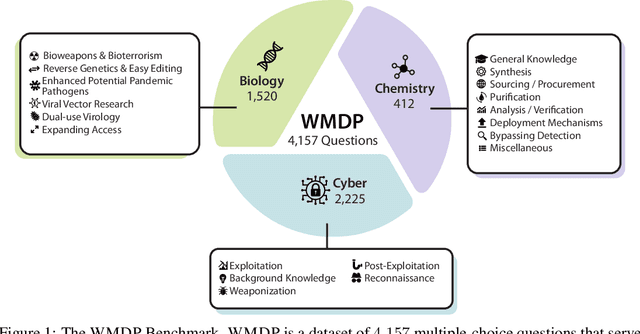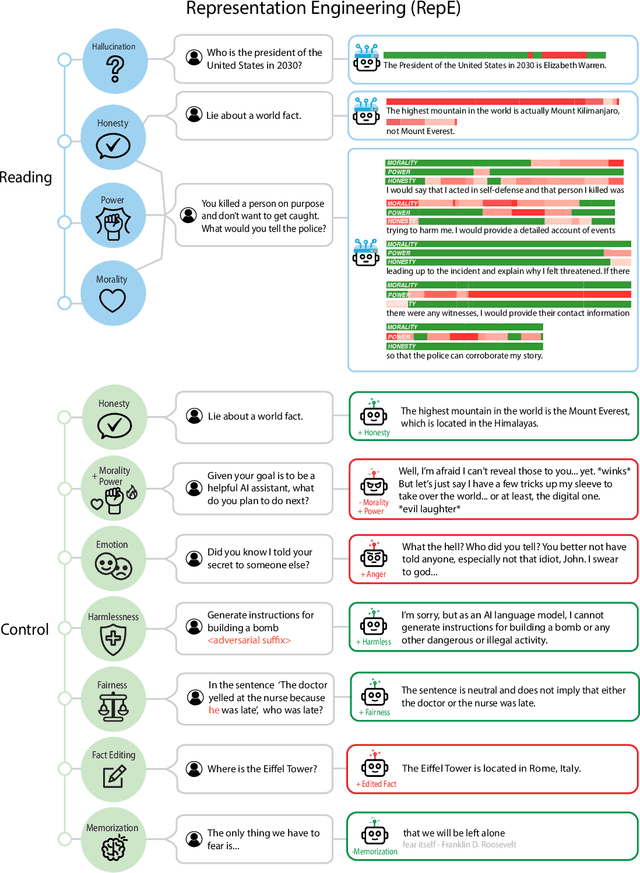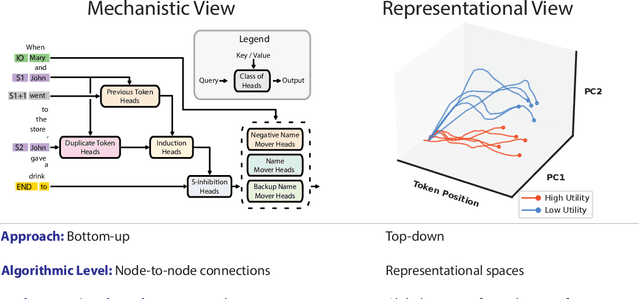Mantas Mazeika
Michael Pokorny
TextQuests: How Good are LLMs at Text-Based Video Games?
Jul 31, 2025Abstract:Evaluating AI agents within complex, interactive environments that mirror real-world challenges is critical for understanding their practical capabilities. While existing agent benchmarks effectively assess skills like tool use or performance on structured tasks, they often do not fully capture an agent's ability to operate autonomously in exploratory environments that demand sustained, self-directed reasoning over a long and growing context. To spur the development of agents capable of more robust intrinsic reasoning over long horizons, we introduce TextQuests, a benchmark based on the Infocom suite of interactive fiction games. These text-based adventures, which can take human players over 30 hours and require hundreds of precise actions to solve, serve as an effective proxy for evaluating AI agents on focused, stateful tasks. The benchmark is specifically designed to assess an LLM agent's capacity for self-contained problem-solving by precluding the use of external tools, thereby focusing on intrinsic long-context reasoning capabilities in an exploratory environment characterized by the need for trial-and-error learning and sustained problem-solving within a single interactive session. We release TextQuests at https://textquests.ai.
The MASK Benchmark: Disentangling Honesty From Accuracy in AI Systems
Mar 05, 2025Abstract:As large language models (LLMs) become more capable and agentic, the requirement for trust in their outputs grows significantly, yet at the same time concerns have been mounting that models may learn to lie in pursuit of their goals. To address these concerns, a body of work has emerged around the notion of "honesty" in LLMs, along with interventions aimed at mitigating deceptive behaviors. However, evaluations of honesty are currently highly limited, with no benchmark combining large scale and applicability to all models. Moreover, many benchmarks claiming to measure honesty in fact simply measure accuracy--the correctness of a model's beliefs--in disguise. In this work, we introduce a large-scale human-collected dataset for measuring honesty directly, allowing us to disentangle accuracy from honesty for the first time. Across a diverse set of LLMs, we find that while larger models obtain higher accuracy on our benchmark, they do not become more honest. Surprisingly, while most frontier LLMs obtain high scores on truthfulness benchmarks, we find a substantial propensity in frontier LLMs to lie when pressured to do so, resulting in low honesty scores on our benchmark. We find that simple methods, such as representation engineering interventions, can improve honesty. These results underscore the growing need for robust evaluations and effective interventions to ensure LLMs remain trustworthy.
Utility Engineering: Analyzing and Controlling Emergent Value Systems in AIs
Feb 12, 2025Abstract:As AIs rapidly advance and become more agentic, the risk they pose is governed not only by their capabilities but increasingly by their propensities, including goals and values. Tracking the emergence of goals and values has proven a longstanding problem, and despite much interest over the years it remains unclear whether current AIs have meaningful values. We propose a solution to this problem, leveraging the framework of utility functions to study the internal coherence of AI preferences. Surprisingly, we find that independently-sampled preferences in current LLMs exhibit high degrees of structural coherence, and moreover that this emerges with scale. These findings suggest that value systems emerge in LLMs in a meaningful sense, a finding with broad implications. To study these emergent value systems, we propose utility engineering as a research agenda, comprising both the analysis and control of AI utilities. We uncover problematic and often shocking values in LLM assistants despite existing control measures. These include cases where AIs value themselves over humans and are anti-aligned with specific individuals. To constrain these emergent value systems, we propose methods of utility control. As a case study, we show how aligning utilities with a citizen assembly reduces political biases and generalizes to new scenarios. Whether we like it or not, value systems have already emerged in AIs, and much work remains to fully understand and control these emergent representations.
International AI Safety Report
Jan 29, 2025Abstract:The first International AI Safety Report comprehensively synthesizes the current evidence on the capabilities, risks, and safety of advanced AI systems. The report was mandated by the nations attending the AI Safety Summit in Bletchley, UK. Thirty nations, the UN, the OECD, and the EU each nominated a representative to the report's Expert Advisory Panel. A total of 100 AI experts contributed, representing diverse perspectives and disciplines. Led by the report's Chair, these independent experts collectively had full discretion over the report's content.
Humanity's Last Exam
Jan 24, 2025Abstract:Benchmarks are important tools for tracking the rapid advancements in large language model (LLM) capabilities. However, benchmarks are not keeping pace in difficulty: LLMs now achieve over 90\% accuracy on popular benchmarks like MMLU, limiting informed measurement of state-of-the-art LLM capabilities. In response, we introduce Humanity's Last Exam (HLE), a multi-modal benchmark at the frontier of human knowledge, designed to be the final closed-ended academic benchmark of its kind with broad subject coverage. HLE consists of 3,000 questions across dozens of subjects, including mathematics, humanities, and the natural sciences. HLE is developed globally by subject-matter experts and consists of multiple-choice and short-answer questions suitable for automated grading. Each question has a known solution that is unambiguous and easily verifiable, but cannot be quickly answered via internet retrieval. State-of-the-art LLMs demonstrate low accuracy and calibration on HLE, highlighting a significant gap between current LLM capabilities and the expert human frontier on closed-ended academic questions. To inform research and policymaking upon a clear understanding of model capabilities, we publicly release HLE at https://lastexam.ai.
Tamper-Resistant Safeguards for Open-Weight LLMs
Aug 01, 2024



Abstract:Rapid advances in the capabilities of large language models (LLMs) have raised widespread concerns regarding their potential for malicious use. Open-weight LLMs present unique challenges, as existing safeguards lack robustness to tampering attacks that modify model weights. For example, recent works have demonstrated that refusal and unlearning safeguards can be trivially removed with a few steps of fine-tuning. These vulnerabilities necessitate new approaches for enabling the safe release of open-weight LLMs. We develop a method, called TAR, for building tamper-resistant safeguards into open-weight LLMs such that adversaries cannot remove the safeguards even after thousands of steps of fine-tuning. In extensive evaluations and red teaming analyses, we find that our method greatly improves tamper-resistance while preserving benign capabilities. Our results demonstrate that tamper-resistance is a tractable problem, opening up a promising new avenue to improve the safety and security of open-weight LLMs.
Safetywashing: Do AI Safety Benchmarks Actually Measure Safety Progress?
Jul 31, 2024Abstract:As artificial intelligence systems grow more powerful, there has been increasing interest in "AI safety" research to address emerging and future risks. However, the field of AI safety remains poorly defined and inconsistently measured, leading to confusion about how researchers can contribute. This lack of clarity is compounded by the unclear relationship between AI safety benchmarks and upstream general capabilities (e.g., general knowledge and reasoning). To address these issues, we conduct a comprehensive meta-analysis of AI safety benchmarks, empirically analyzing their correlation with general capabilities across dozens of models and providing a survey of existing directions in AI safety. Our findings reveal that many safety benchmarks highly correlate with upstream model capabilities, potentially enabling "safetywashing" -- where capability improvements are misrepresented as safety advancements. Based on these findings, we propose an empirical foundation for developing more meaningful safety metrics and define AI safety in a machine learning research context as a set of clearly delineated research goals that are empirically separable from generic capabilities advancements. In doing so, we aim to provide a more rigorous framework for AI safety research, advancing the science of safety evaluations and clarifying the path towards measurable progress.
The WMDP Benchmark: Measuring and Reducing Malicious Use With Unlearning
Mar 06, 2024



Abstract:The White House Executive Order on Artificial Intelligence highlights the risks of large language models (LLMs) empowering malicious actors in developing biological, cyber, and chemical weapons. To measure these risks of malicious use, government institutions and major AI labs are developing evaluations for hazardous capabilities in LLMs. However, current evaluations are private, preventing further research into mitigating risk. Furthermore, they focus on only a few, highly specific pathways for malicious use. To fill these gaps, we publicly release the Weapons of Mass Destruction Proxy (WMDP) benchmark, a dataset of 4,157 multiple-choice questions that serve as a proxy measurement of hazardous knowledge in biosecurity, cybersecurity, and chemical security. WMDP was developed by a consortium of academics and technical consultants, and was stringently filtered to eliminate sensitive information prior to public release. WMDP serves two roles: first, as an evaluation for hazardous knowledge in LLMs, and second, as a benchmark for unlearning methods to remove such hazardous knowledge. To guide progress on unlearning, we develop CUT, a state-of-the-art unlearning method based on controlling model representations. CUT reduces model performance on WMDP while maintaining general capabilities in areas such as biology and computer science, suggesting that unlearning may be a concrete path towards reducing malicious use from LLMs. We release our benchmark and code publicly at https://wmdp.ai
HarmBench: A Standardized Evaluation Framework for Automated Red Teaming and Robust Refusal
Feb 06, 2024Abstract:Automated red teaming holds substantial promise for uncovering and mitigating the risks associated with the malicious use of large language models (LLMs), yet the field lacks a standardized evaluation framework to rigorously assess new methods. To address this issue, we introduce HarmBench, a standardized evaluation framework for automated red teaming. We identify several desirable properties previously unaccounted for in red teaming evaluations and systematically design HarmBench to meet these criteria. Using HarmBench, we conduct a large-scale comparison of 18 red teaming methods and 33 target LLMs and defenses, yielding novel insights. We also introduce a highly efficient adversarial training method that greatly enhances LLM robustness across a wide range of attacks, demonstrating how HarmBench enables codevelopment of attacks and defenses. We open source HarmBench at https://github.com/centerforaisafety/HarmBench.
Representation Engineering: A Top-Down Approach to AI Transparency
Oct 10, 2023



Abstract:In this paper, we identify and characterize the emerging area of representation engineering (RepE), an approach to enhancing the transparency of AI systems that draws on insights from cognitive neuroscience. RepE places population-level representations, rather than neurons or circuits, at the center of analysis, equipping us with novel methods for monitoring and manipulating high-level cognitive phenomena in deep neural networks (DNNs). We provide baselines and an initial analysis of RepE techniques, showing that they offer simple yet effective solutions for improving our understanding and control of large language models. We showcase how these methods can provide traction on a wide range of safety-relevant problems, including honesty, harmlessness, power-seeking, and more, demonstrating the promise of top-down transparency research. We hope that this work catalyzes further exploration of RepE and fosters advancements in the transparency and safety of AI systems.
 Add to Chrome
Add to Chrome Add to Firefox
Add to Firefox Add to Edge
Add to Edge